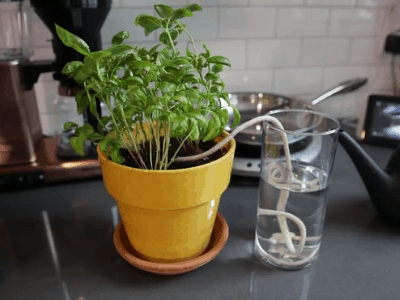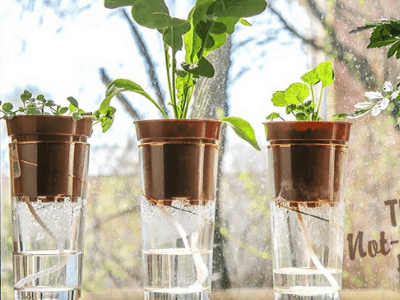
Self Watering Device, Is It Possible?
Some of your indoor plants require water every few days, while others can go without for a week or two.
In any case, you’ll need to water them on a regular basis, which can eat up time that you don’t have.
Wouldn’t it be nice if your houseplants were watered by a planter? Is this even possible, and if so…
….would it be beneficial to your plants? If you’re unfamiliar with self-watering planters and pots…
…I think you’ll appreciate the information in this article.
When it comes to indoor plants, are self watering planters a smart idea?
Yes, indeed! Most indoor plants, particularly tropical plants, vegetables, annuals, and perennials, thrive in self-watering planters.
Self-watering planters aren’t necessary for houseplants that prefer moist soil, as maintaining…
…the required level of moisture is difficult. I’ll cover everything you need to know about self-watering planters…
…in this comprehensive guide. I’ll even share a couple of my favorite self-watering planters…
…also known as self-watering pots, with you near the end of this article so you’ll know which ones I recommend.
Here we have story from Sally about her experience using self watering for her snake plant.
Let us hear Sally story
I have to say, I found it a little tough to find the right pot for my snake plant.
You see, they get tall and are like tanks taking over the place if you don’t give them their space.
But all of that is in the past because now I’ve found this awesome self-watering planter!
It’s a genius idea! All you do is put some water at the bottom of your pot and set up your plants…
…with these pots on top of them. When it gets dry, just fill up the holes and voila!
The plant stays moist all day long so no more worries about forgetting to water again.

It’s time to get in vacation mode and leave your responsibilities behind! But before you go, make sure that your plant babies are accounted for, you’ve taken such good care of them and would hate to see them withering away when you return.
Erica Daniels, author from proflowers.com
Here’s the main thing!
Watering Requirement for Snake Plant
Before I go any further, I’d like to make sure we all understand what a self-watering planter is and how it functions.
A self-watering planter is a pot or tub for your indoor plants that isn’t like any other.
The main pot holds your soil and houseplant, but a bottom reservoir, also known as an outer pot…
…or water storage tank, holds any excess water. The only thing you’d have to do is fill up the water storage tank.
You could check on the water levels once a week and refill as required, but your job is extremely fast and simple.
The wick connects the outer and inner pots of the self-watering planter, allowing water to easily travel up…
…to the root ball and nourish your plant.

Do Self Watering Planters Help Indoor Plants?
If you’re an enthusiastic indoor gardener like me, you’re always searching for ways to save time…
…while caring for all of your plants. A commercially made hack like a self-watering planter…
…can make your life so much easier. How are your houseplants doing? Would a self-watering planter support them
…or should you just put up with it and water your plants manually every few days?
A self-watering planter would undoubtedly help your indoor plants. Here’s how to do it.

Overflow Hole Prevents Root Rot
Some houseplants, such as jade plants, spider plants, and English ivy, thrive in water.
Most plants don’t like too much water, as it can cause root rot if the roots are overwatered.
Root rot can be fatal to your bad houseplant in many instances. If your houseplant survives…
…you’ll probably have to cut off a lot of the roots, leaves, and stems just to give it a fighting chance.
To you, excess water from a self-watering planter will appear to be a perfect environment…
…for your houseplant to grow root rot. Your self-watering planter’s overflow hole…
…on the other hand, ensures that your plant never gets more water than it needs.
The overflow hole, as the name implies, drains any excess water that may have accumulated.
Let’s say your self-watering planter’s wick or another component broke down. Even so, the planter’s…
…overflow hole ensures that any excess water drains away, preventing your houseplant…
…from being overwatered and developing root rot.

Go on…
Efficient Use of Water
You’re very aware of how much water you need, both for your houseplants and for your daily life at home.
You don’t want to waste any of your water. In that case, you should consider investing…
…in a self-watering planter for your indoor garden. Moisture-wicking systems are available….
….on some self-watering planters, making them even more efficient. When there is water in the chamber…
….the moisture-wicking device absorbs it and sends it to the plant in the form of water.
Well, ideally, you might use the same water indefinitely, but that isn’t true.
A self-watering planter often delivers water more precisely than a spray bottle or a watering can.
You have no control of where the water goes with any of those solutions, which is inefficient.
The water in the planter still finds its way to its intended target, the plant’s roots, without being diverted.
Keep reading
Even Moisture Levels
When the plant absorbs the water, it reaches the soil from the bottom up, rather than the top down…
…as you would in a typical houseplant watering. This does not seem to be helpful, but it is, and it is extremely so.
This method of water distribution ensures that moisture is delivered directly to the roots of your indoor plant…
…and that it is distributed uniformly.
Lower Risk of Fungal Diseases
Another advantage of using a self-watering planter and watering from the ground up?
Houseplants that are healthier and live longer. Water gets on the leaves when you water your houseplant..
…from the top down, even though you’re aiming for the roots. If the leaves are oversaturated on a regular basis..
…they are more likely to develop fungal diseases. Using a self-watering planter helps to keep the leaves dry.
You will need to mist the leaves to clean them every now and then, depending on the houseplant species…
….such as a philodendron, but the plant is otherwise safe and happy.
Next up…
Feeds Nutrients as Well as Water
You can use your self-watering planter to distribute plant food and nutrients directly to the root system…
….of your thirsty plant, in addition to providing water. Slow-release nutrients will provide your plant…
….with the nutrition it needs for three to four weeks at a time.
The Downsides of Self Watering Planters
In this part, I’m not discouraging you from purchasing a self-watering planter. It’s always a good idea…
…to look at a product from both sides before making a purchase. Here are several potential pitfalls to avoid.
Hot Weather Can Make the Water Evaporate
Since the water evaporates more quickly in hotter climates, you will need to refill the planter more often.
This is inconvenient because it negates the majority of the advantages of having a self-watering planter.
Last but not least
Not Good for All Types of Plants
Many houseplants, as I described in the introduction, are suitable for a self-watering planter.
Herbs, garlic, cabbage, carrots, and tomatoes are examples of tropical plants and vegetables.
These annuals should do well in a self-watering jar if you like annuals. Perennials, especially hostas…
…and Japanese irises, are in the same boat. Plants that require very moist soil, on the other hand, do not thrive….
…in a self-watering planter. Watering from the bottom up seldom provides the amount of moisture…
…that certain houseplants need, which can cause them to dry out and suffer as a result…
…of using the self-watering planter.
Sum Up
See having Snake plant is good choice for you to have! It’s cool, its famous, it’s easy to have and care!
What else do you need? In this pandemic time like this, is a good choice for you to have an new activity…
…and having snake plant is a good choice for you to have!
Conclusion
Last thing for sure. This plant need to be care carefully, remember plant need the “love” too.
Alright that’s all for today! Do you have any questions about all of this?
Or do you want to add some varieties that are a good choice for you to have as houseplant?
Let me know your recommendation from the comment below.
I hope you can now take care your snake carefully and grow it big!
Thanks for reading this article! Bye!

